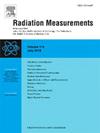Determination of the sensitive volume of a spherical ion chamber as a potential primary standard instrument for higher energy photon beams
IF 2.2
3区 物理与天体物理
Q2 NUCLEAR SCIENCE & TECHNOLOGY
引用次数: 0
Abstract
The sensitive volume of cylindrical or parallel plate ion chamber used as a primary standard for air kerma is typically determined using mechanical tools. This study presents an alternative methodology to determine the sensitive volume for a spherical chamber using a high-resolution imaging system, such as a microcomputed tomography unit (microCT). These determinations were done independently at both the University of Wisconsin (UW) and at State University of Rio de Janeiro (UERJ). The internal dimensions and the collection electrode of a spherical chamber (model Exradin® A3, Standard Imaging) were determined with a resolution better than the manufacturer's nominal volume value of 3.6 cm3 for the A3. In this study, at UERJ the measured sensitive volume of the A3 chamber was found to be 3.52 cm3 and at UW, after a correction for the electric field was made for the volume determination, it was found to be 3.54 cm3. The measured sensitive volume was compared against the volume calculated from an ADCL air kerma calibration with 60Co at the UW. The agreement between these two methods was within 0.65%. Note that the chambers at UW and UERJ are two independent chambers and thus, the volume would not necessarily agree.
作为高能光子光束潜在主要标准仪器的球形离子室敏感体积的测定
圆柱形或平行板离子室的敏感体积作为空气质量的主要标准,通常使用机械工具来确定。本研究提出了一种利用高分辨率成像系统(如微型计算机断层扫描单元(microCT))确定球形室敏感体积的替代方法。这些测定是在威斯康星大学(UW)和里约热内卢州立大学(UERJ)独立完成的。球体室(Exradin®A3,标准成像)的内部尺寸和收集电极的分辨率优于制造商的A3标称体积值3.6 cm3。在本研究中,在UERJ下测得A3腔体的敏感体积为3.52 cm3,在UW下,对电场进行校正后测得的敏感体积为3.54 cm3。测量的敏感体积与在UW使用60Co的ADCL空气kerma校准计算的体积进行比较。两种方法的一致性在0.65%以内。请注意,西澳大学和UERJ的分庭是两个独立的分庭,因此,体积不一定一致。
本文章由计算机程序翻译,如有差异,请以英文原文为准。
求助全文
约1分钟内获得全文
求助全文
来源期刊

Radiation Measurements
工程技术-核科学技术
CiteScore
4.10
自引率
20.00%
发文量
116
审稿时长
48 days
期刊介绍:
The journal seeks to publish papers that present advances in the following areas: spontaneous and stimulated luminescence (including scintillating materials, thermoluminescence, and optically stimulated luminescence); electron spin resonance of natural and synthetic materials; the physics, design and performance of radiation measurements (including computational modelling such as electronic transport simulations); the novel basic aspects of radiation measurement in medical physics. Studies of energy-transfer phenomena, track physics and microdosimetry are also of interest to the journal.
Applications relevant to the journal, particularly where they present novel detection techniques, novel analytical approaches or novel materials, include: personal dosimetry (including dosimetric quantities, active/electronic and passive monitoring techniques for photon, neutron and charged-particle exposures); environmental dosimetry (including methodological advances and predictive models related to radon, but generally excluding local survey results of radon where the main aim is to establish the radiation risk to populations); cosmic and high-energy radiation measurements (including dosimetry, space radiation effects, and single event upsets); dosimetry-based archaeological and Quaternary dating; dosimetry-based approaches to thermochronometry; accident and retrospective dosimetry (including activation detectors), and dosimetry and measurements related to medical applications.
 求助内容:
求助内容: 应助结果提醒方式:
应助结果提醒方式:


